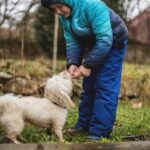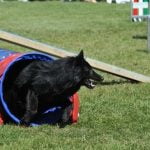Service dogs play a crucial role in assisting individuals with disabilities, medical conditions, and other special needs. Among the various types of training service dogs undergo, scent training is particularly important as it enables them to perform tasks such as detecting allergens, alerting to seizures, or finding a missing person. In this article, we will explore the significance of scent training for service dogs and provide valuable insights into how to effectively train them in this specialized skill.
Understanding the olfactory capabilities of dogs is essential in comprehending why scent training is so vital. Dogs have an incredibly powerful sense of smell, with up to 300 million olfactory receptors in their noses compared to about 5-6 million in humans.
This gives them the ability to detect scents that are undetectable to humans and makes them invaluable assets in various service roles. By understanding the science behind their sense of smell, we can better appreciate how scent training plays a crucial role in enhancing a service dog’s abilities.
In the following sections, we will delve into the process of scent training for service dogs, starting with the necessary preparation and tools required for successful training. We will also cover basic and advanced scent training exercises, tailored techniques for different service dog roles, as well as troubleshooting common challenges that may arise during the training process.
Additionally, we will explore the practical benefits of scent training and its real-life applications for service dogs. With this comprehensive guide, you will gain a deeper understanding of how to effectively scent train a service dog for maximum effectiveness in their designated roles.
The Science Behind Scent Training
The olfactory system of a dog is truly remarkable, and it plays a crucial role in their ability to scent train effectively. Understanding the science behind this system is essential for anyone looking to train a service dog to detect specific scents.
Dogs have an incredibly strong sense of smell, with an estimated 300 million olfactory receptors in their noses, compared to about six million in humans. This means that dogs are able to detect scents at incredibly low concentrations, making them invaluable for tasks such as search and rescue or medical alert.
How the Olfactory System Works
The olfactory system works by allowing dogs to take in scent particles from the air and then process them in a specialized part of their brain. When a dog inhales, they can differentiate between different components of a smell, allowing them to recognize specific scents. Additionally, dogs have a second smelling mechanism called the Jacobson’s organ or vomeronasal organ, which allows them to detect pheromones and other chemical signals from other animals.
The Relationship Between Scent Training and the Olfactory System
Scent training takes advantage of the dog’s incredible sense of smell by teaching them to identify and locate specific scents. By understanding how the olfactory system works, trainers can design effective training programs that capitalize on the dog’s natural abilities. Through targeted exercises and consistent practice, service dogs can be taught to detect everything from drugs and explosives to medical conditions like diabetes or seizures.
Aspiring service dog trainers should familiarize themselves with the science behind their canine companions’ olfactory capabilities in order to fully appreciate how these abilities can be honed through proper scent training techniques. Understanding this connection will ultimately contribute to successful scent training outcomes for service dogs performing vital roles in various capacities.
Getting Started
To properly scent train a service dog, it is crucial to have the right tools and create an appropriate training environment. The following sub-sections will guide you on how to prepare for scent training and set up the ideal conditions for your service dog’s olfactory education.
Gathering Training Tools
Before beginning scent training, it is essential to gather the necessary tools. These may include scent detection kits with various scents, such as essential oils or specific odors related to the intended service dog role. Additionally, you will need reward treats for positive reinforcement, a leash and collar for control during training exercises, and a designated area free from distractions.
Setting Up the Training Environment
When setting up the training environment for scent work, choose a quiet and familiar location where your service dog can focus without interruptions. A well-ventilated space is important to ensure that your dog can pick up scents effectively. It is also beneficial to have different surfaces available for training, such as grass, concrete, or carpet, as this will help your dog generalize their search abilities in various environments.
Gradual Introduction to Scent Training
Once you have prepared the necessary tools and established a suitable training environment, it is important to introduce your service dog gradually to scent training. Start with one specific scent at a time and slowly increase difficulty levels as your dog becomes proficient.
Remember that patience and consistency are key components of successful scent training. By following these steps and guidelines on how to scent train a service dog effectively, you can lay the foundation for developing vital skills that will benefit both your dog and those they serve.
Basic Scent Training Exercises
Scent training is a crucial aspect of preparing a service dog for its role in assisting individuals with disabilities or performing important tasks in various settings. This section will provide a step-by-step guide on how to scent train a service dog, starting with the basic exercises that lay the foundation for more advanced scent training techniques.
First and foremost, it’s important to select the specific scents that the service dog will be trained to identify and locate. These scents could vary depending on the intended role of the service dog, such as medical alert, search and rescue, or even detecting allergens. Once the scents have been identified, it is essential to use positive reinforcement and rewards during training sessions to create a positive association with the targeted scents.
The next step in basic scent training involves introducing the chosen scents to the service dog. This can be done by placing small amounts of the scents on specific materials, such as cotton swabs or small pieces of fabric, and presenting them to the dog while creating a positive environment. The dog should be encouraged to sniff and investigate these materials, followed by praise and rewards for showing interest in the scents.
To further develop their ability to identify and locate specific scents, gradual progression is key. This can involve hiding the scented materials in simple locations at first before moving on to more challenging hiding spots. As with any form of training, patience, consistency, and positive reinforcement are crucial for successfully teaching a service dog to identify and locate specific scents.
| Training Tools | Importance |
|---|---|
| Scented materials (cotton swabs, fabric) | Essential for introducing specific scents to the service dog |
| Rewards/Treats | Used for positive reinforcement during training sessions |
| Gradually challenging hiding spots | Helps in progressing the dog’s ability to identify scents |
Advanced Scent Training Techniques
After mastering the basic scent training exercises, it is important to introduce distractions and increase difficulty levels in scent training for service dogs. This advanced stage of training is crucial for preparing the dog to perform effectively in real-life scenarios where they may encounter various distractions and challenging conditions. Here are some techniques to take your service dog’s scent training to the next level:
- Introduce background noise: Start by introducing low levels of background noise during scent training sessions, gradually increasing the volume as the dog becomes more accustomed to working in distracting environments.
- Utilize different locations: Practice scent detection in a variety of locations such as parks, crowded streets, and indoor facilities to simulate real-life situations. This will help the dog generalize their scent detection skills across different environments.
- Implement time constraints: Set time limits for the dog to locate specific scents, encouraging them to work efficiently and stay focused amidst time pressure.
By incorporating these advanced scent training techniques, service dogs can develop resilience and adaptability in their ability to detect scents even in challenging situations.
Moreover, gradually increasing the difficulty levels of scent training can also involve introducing unfamiliar scents that the dog has not been previously exposed to. This helps expand the dog’s range of detectable scents and enhances their overall olfactory capabilities. Additionally, varying the difficulty levels keeps the training sessions engaging and mentally stimulating for the service dog, preventing boredom and maintaining their enthusiasm for scent work.
Scent Training for Different Roles
Service dogs play a crucial role in various tasks such as medical alert and search and rescue. Scent training is especially important for these roles as it allows the dog to use their exceptional sense of smell to identify specific scents and locate people or items. In this section, we will discuss how to tailor scent training for different service dog roles.
For medical alert service dogs, scent training is essential for detecting changes in a person’s body chemistry that signals an impending medical emergency such as seizures, diabetic episodes, or allergic reactions. The first step in scent training for medical alert is to select the specific scent associated with the medical condition and begin conditioning the dog to recognize and respond to it.
This can be achieved through positive reinforcement techniques such as clicker training and rewards when the dog successfully identifies the targeted scent.
In contrast, search and rescue dogs are trained to locate missing persons in various environments such as wilderness areas or disaster sites. Scent training for search and rescue dogs involves teaching them to detect human scent over long distances and challenging terrains.
Handlers often use specialized equipment such as scent articles (clothing or personal items belonging to the missing person) to train the dog to track and find the individual based on their unique odor. It is crucial for search and rescue dogs to undergo rigorous scent training under different conditions to ensure they can perform effectively in real-life search missions.
| Service Dog Role | Suggested Training Technique |
|---|---|
| Medical Alert | Conditioning the dog with positive reinforcement techniques such as clicker training |
| Search and Rescue | Using specialized equipment like scent articles and conducting rigorous training under diverse conditions |
Overall, tailoring scent training for specific service dog roles requires understanding the unique requirements of each task, selecting appropriate scents, providing consistent practice sessions, and gradually increasing the difficulty level. By customizing the training approach based on the intended role of the service dog, handlers can maximize their effectiveness in carrying out their designated duties. With proper scent training, service dogs can make a significant impact by saving lives and providing valuable assistance in various situations.
Troubleshooting Common Challenges
One common challenge in scent training a service dog is the dog getting distracted by other scents in the environment. This can be particularly difficult when training in public spaces or areas with high foot traffic.
To overcome this obstacle, it is important to start training in a controlled environment with minimal distractions and gradually increase the level of difficulty as the dog becomes more proficient in scent detection. Introducing distractions gradually and using positive reinforcement techniques can help the dog stay focused on the target scent.
Another common issue is a lack of motivation in the dog during scent training sessions. Some dogs may become disinterested or lose motivation if they are not properly rewarded for their efforts. In such cases, it is essential to use high-value treats or rewards that are particularly enticing for the dog. Additionally, incorporating play and interactive games into the training sessions can help keep the dog engaged and motivated to continue scent training.
Additionally, some dogs may exhibit signs of stress or anxiety during scent training, especially when introduced to new scents or environments. It is crucial for handlers to pay close attention to their dog’s body language and behavior to identify signs of stress.
If a dog appears stressed during scent training, it may be necessary to take a step back and proceed at a slower pace, ensuring that the dog feels comfortable and safe throughout the training process. Using calming techniques such as massage or relaxation exercises can also help alleviate stress and anxiety in dogs during scent training sessions.
Overall, addressing these common challenges in scent training requires patience, consistency, and understanding of the individual needs of each service dog. With proper guidance and tailored solutions, most obstacles can be overcome, leading to successful scent training outcomes for service dogs in various roles.
Benefits of Scent Training
Scent training for service dogs goes beyond just teaching them to identify specific scents. It has a direct impact on their ability to perform their roles effectively in real-life scenarios. Here are some of the practical applications and positive impacts of scent training for service dogs:
- Alerting to Medical Conditions: One of the most crucial roles of a service dog is to alert their handler to specific medical conditions, such as diabetes or seizures. Through scent training, these dogs can learn to detect changes in their handler’s body odor that indicate an impending medical issue. This ability can potentially save lives by giving the handler enough time to take necessary precautions or seek help.
- Search and Rescue Missions: Scent-trained service dogs are invaluable in search and rescue missions, where they can use their keen sense of smell to locate missing persons or even detect human remains. By honing their scent detection skills, these dogs become essential assets in emergency situations, providing critical assistance to rescue teams and law enforcement agencies.
- Improving Quality of Life: Scent training enhances a service dog’s overall effectiveness in assisting individuals with disabilities. For example, a dog trained to detect allergens can help their handler avoid potential allergic reactions by alerting them to the presence of allergens in the environment. Similarly, a dog trained to recognize specific scents related to PTSD triggers can provide crucial support by intervening before an anxiety or panic attack escalates.
The practical applications and positive impact of scent training for service dogs extend far beyond the training sessions themselves – they directly contribute to the well-being and safety of both the handlers and those around them. As such, ongoing scent training plays a vital role in ensuring that service dogs are fully prepared and capable of fulfilling their important roles in various real-life scenarios.
Conclusion
In conclusion, scent training for service dogs is an essential aspect of their overall training and development. Through understanding the science behind scent training and implementing basic and advanced techniques, service dogs can become proficient in identifying specific scents and locating their source. The benefits of scent training extend beyond just their ability to perform tasks – it also enhances their focus, mental stimulation, and overall effectiveness in assisting individuals with various needs.
It is important to note that scent training is an ongoing process that requires patience, consistency, and dedication from both the handler and the dog. As such, it is crucial to continue practicing scent training exercises regularly to maintain and improve the dog’s skills. Additionally, tailoring scent training for different service dog roles, such as medical alert or search and rescue, allows for specialized training that meets specific needs.
Ultimately, mastering how to scent train a service dog not only enhances their capabilities in performing essential tasks but also strengthens the bond between the service dog and their handler. By emphasizing the significance of ongoing scent training and recognizing its practical applications in real-life scenarios, we can ensure that service dogs are well-prepared to provide invaluable assistance to those who rely on them.
Frequently Asked Questions
Can I Get a Service Dog if I Can’t Smell?
Yes, individuals who are unable to smell can still benefit from having a service dog. Service dogs can be trained to perform various tasks such as alerting their owner to alarms or dangerous scents, providing companionship, and assisting with physical tasks.
What Can I Use to Scent Train My Dog?
Scent training for dogs typically involves using essential oils or scent samples to teach the dog to recognize and respond to specific scents. This training can be customized based on the individual needs of the handler, such as detecting allergens, medical alerts, or other specific scents.
How Do I Get My Dog to Pass as a Service Dog?
To get your dog to pass as a service dog, it is essential to ensure that the dog is well-trained and able to perform tasks that mitigate the handler’s disability. Additionally, it’s important for the dog to exhibit good behavior in public settings and remain calm and obedient in various situations.
Professional training and certification can also help validate the dog’s status as a service animal.

Welcome to the blog! I am a professional dog trainer and have been working with dogs for many years. In this blog, I will be discussing various topics related to dog training, including tips, tricks, and advice. I hope you find this information helpful and informative. Thanks for reading!





